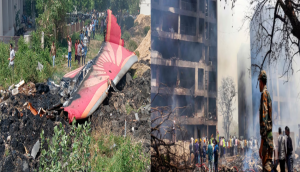
A triple plate junction in Pakistan, located just 50 kilometres away from Balochistan's coast, faces potentially high tsunami risk, warned experts at a workshop held in the city of Karachi on Wednesday.
The awareness programme on an early warning system for hazards like tsunami noted the Makran subduction zone had the potential to generate future tsunamis in the Arabian Sea and the Indian Ocean, Dawn newspaper reported.
The Pakistani daily said more than 4,000 people were killed along Pakistan's coast and neighbouring countries like Iran, India and Oman by tsunami in 1945.
"Pakistan is situated in a tectonically very active zone, lying at the triple plate junction of Indian, Eurasian and Arabian plate boundaries, where the Indian plate pushes into the Eurasian plate," said Tariq Ibrahim of Pakistan Met department.
"We would just have 15 to 20 minutes to analyse the situation and respond. While Gwadar has elevated front, its areas of East and West Bay are very vulnerable in case a tsunami occurs of the same intensity that struck in 1945. It will also inundate Gwadar port and the city," he said.
Citing data generated with the help of simulation studies, Ibrahim said one to two-kilometre area of Karachi's coast was very vulnerable to damage. "The many tributaries of the Indus delta make Sindh's coast very vulnerable (to tsunami threat)."
"Pakistan is situated in a tectonically very active zone, lying at the triple plate junction of Indian, Eurasian and Arabian plate boundaries, where the Indian plate pushes into the Eurasian plate," he said.
He said both the Karakoram and Hindu Kush ranges were caused by the collision of the Indian plate into the Eurasian plate. The Hindu Kush and the Pamir constituted one of the most seismically active earthquake zones in the world, he added.
"We had 4,039 earthquakes in Pakistan in six years (2008-2014). But, most of them were of light and minor intensity (ranging between one and 4.9 magnitude)," he said.
This event on media awareness on an early warning system was organized by the Pakistan Meteorological Department (PMD) in collaboration with UN Development Programme.
(ANI)
Also Read: UN welcomes dialogue between US, Russia after Putin-Biden call







![BJP's Kapil Mishra recreates Shankar Mahadevan’s ‘Breathless’ song to highlight Delhi pollution [WATCH] BJP's Kapil Mishra recreates Shankar Mahadevan’s ‘Breathless’ song to highlight Delhi pollution [WATCH]](https://images.catchnews.com/upload/2022/11/03/kapil-mishra_240884_300x172.png)

![Anupam Kher shares pictures of his toned body on 67th birthday [MUST SEE] Anupam Kher shares pictures of his toned body on 67th birthday [MUST SEE]](https://images.catchnews.com/upload/2022/03/07/Anupam_kher_231145_300x172.jpg)






